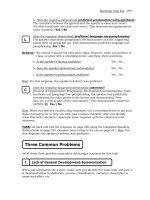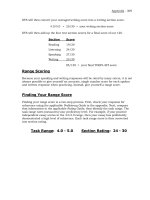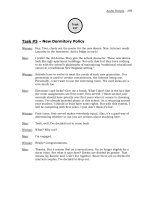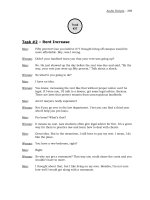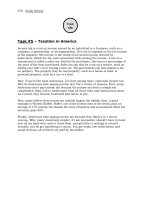CO EVOLUTIONARY BIDDING AND COOPERATION STRATEGIES FOR BUYERS IN POWER MARKETS
Bạn đang xem bản rút gọn của tài liệu. Xem và tải ngay bản đầy đủ của tài liệu tại đây (8.19 MB, 128 trang )
CO-EVOLUTIONARY BIDDING AND
COOPERATION STRATEGIES FOR BUYERS IN
POWER MARKETS
LY TRONG TRUNG
B.Eng. (Hons.), NUS
A THESIS SUBMITTED
FOR THE DEGREE OF MASTER OF ENGINEERING
DEPARTMENT OF ELECTRICAL & COMPUTER ENGINEERING
NATIONAL UNIVERSITY OF SINGAPORE
2012
i
ii
ACKNOWLEDGEMENT
First and foremost, I would like to thank my supervisor, Associate Professor Dipti
Srinivasan for proposing this exciting research topic and her invaluable time
guiding me to the right direction throughout the whole project. Her
encouragement and advice have always motivated me and kept me on track
throughout my candidature.
Secondly, I would like to thank my project examiner, Assistant Professor Panida
Jirutitijaroen for her precious feedback and contributions to my work during the
Continuous Assessment sessions.
Next, I would like to thank Mr Seow Hung Cheng - the Energy Management &
Microgrid Laboratory Officer for his help on the administrative and technical
support.
I also would like to thank Thillainathan Logenthiran and Deepak Sharma - the
research staffs at the same laboratory for sharing their experiences and ideas.
Lastly, my graduate study at National University of Singapore was made possible
through the research scholarship. I am extremely thankful to NUS for the financial
support.
iii
iv
TABLE OF CONTENTS
ACKNOWLEDGEMENT ..................................................................................... iii
SUMMARY ......................................................................................................... viii
LIST OF TABLES ..................................................................................................xi
LIST OF FIGURES .............................................................................................. xii
LIST OF PUBLICATIONS RELATED TO THIS THESIS………………...….xiii
Chapter 1: INTRODUCTION..................................................................................1
1.1
Overview of the deregulated power market ...............................................1
1.1.1
Electricity and natural monopoly ..................................................1
1.1.2
Movement to a new competitive market .......................................3
1.1.3
Deregulated power market models ...............................................4
1.2
Motivation of the research ..........................................................................5
1.3
Structure of the thesis .................................................................................6
Chapter 2: REVIEW OF POWER MARKET MODELS ........................................8
2.1
Background of Agent Based Technology ..................................................8
2.2
Multi-Agents in economics ......................................................................10
2.3
Multi-Agents in power systems ................................................................12
2.4
Power market modelling using Evolutionary Algorithms in Agent-based
framework ................................................................................................13
2.5 Cooperative Game and Optimal Coalition................................................15
2.6 Chapter conclusions ..................................................................................16
Chapter 3: PROPSED METHODOLOGY FOR MODELING POWER
MARKETS ..........................................................................................18
3.1
Co-evolutionary approach for deterministic situation ............................. 21
3.1.1
Principle of Evolutionary Algorithms .........................................21
v
3.1.2
3.2
3.3
Towards Co-evolutionary ...........................................................23
Evolutionary Cooperative Game approach for stochastic situation .........26
3.2.1
Cooperative Game concepts .......................................................26
3.2.2
Optimal Coalition Structure Generation problem .......................28
Value at Risk and group characteristic function ......................................30
3.4 Chapter conclusions ..................................................................................32
Chapter 4: SINGLE-NODE POWER MARKET MODEL ...................................33
4.1
The single-node power market model ......................................................33
4.2
Generator and buyer models ..................................................................... 34
4.3
The bidding model and market calculation ..............................................36
4.4
The co-evolution model............................................................................39
Chapter 5: SIMULATION OF SINGLE-NODE POWER MARKET MODEL ...43
5.1
Competition scenario ...............................................................................43
5.2
Verification of Nash equilibrium .............................................................45
5.3
Cooperation scenario ...............................................................................46
5.4
The free rider problem .............................................................................50
5.5
Cooperation schemes for small buyers ....................................................52
5.6
Summary of results analysis ....................................................................55
Chapter 6: MULTI-NODE POWER MARKET MODEL.....................................57
6.1
The multi-node power market model .......................................................57
6.2
Generator and buyer models.....................................................................58
6.3
The bidding model and market calculation ..............................................60
Chapter 7: IMPLEMENTATION OF MULTI-NODE
POWER MARKET MODEL……………………………………...…63
7.1
Test network .............................................................................................63
7.2
Market database ........................................................................................65
7.3
Chromosome structures ............................................................................67
vi
Chapter 8: SIMULATION OF MULTI-NODE POWER MARKET MODEL.....69
8.1
8.2
8.3
Deterministic situation .............................................................................69
8.1.1
Individual bidding .......................................................................69
8.1.2
Total cooperation ........................................................................71
8.1.3
Total cooperation with Pareto improvement...............................72
8.1.4
Group cooperation ......................................................................74
8.1.5
Comparison of different schemes of cooperation .......................77
Stochastic situation ...................................................................................79
8.2.1
Test on IEEE 14 bus system .......................................................79
8.2.2
Test on IEEE 30 bus system .......................................................83
Summary of results analysis ....................................................................85
Chapter 9: CONCLUSION ....................................................................................88
9.1 Contributions.............................................................................................88
9.2 Suggestions for future work ......................................................................91
REFERENCES .....................................................................................................93
APPENDIX ..........................................................................................................100
A.
From Evolutionary Algorithms To Co-Evolutionary Algorithms ..........100
vii
SUMMARY
Deregulation of electric power industries in recent years has opened many
opportunities for electricity buyers. However, the strong influence of network
physical constraints may result in economic decisions that adversely affect the
interests of the consumers. Compared to the monopolistic economy of yesteryears,
electricity buyers may now actually be able to influence the market by cooperating
with other buyers in the electrical power network. This research presents different
models using agent-based co-evolutionary framework for evolving individual and
cooperative strategies of electricity buyers in a power market.
To realize the above objectives, simulations involving evolutionary
algorithms and multi-agent systems are used to study a single-node system, where
economic agents are modeled by their supply / demand functions, and then a
multi-node system, where the technical constraints of the power distribution
network are fully taken into account. The results of the single-node model show
that it is of great benefit to cooperate but the free rider problem may arise when an
individual buyer gains more profit due to the cooperative effort of the others.
The multi-node model is investigated through two situations. First, we
focus on deterministic cases where buyers choose their bidding strategies to
maximize the profits in different scenarios of playing individually or
cooperatively. It is also found that by evolutionary learning, buyers can benefit
from cooperation. Next, the uncertain nature of the market is modeled where
buyers find optimal cooperation strategies to hedge against the risk of low
viii
payoffs. Our approach is universal since it can be applied to study the behaviors of
buyers with any objective for cooperation. We proved a theorem to link the payoff
distribution problem in cooperative game theory with the optimal coalition
structure generation problem in combinatorial optimization theory. The
statistically consistent simulation results show that our approach is able to
discover interesting cooperation strategies, and can be easily extended for
practical networks with large number of buyers.
ix
x
LIST OF TABLES
Table 4.1: Data of generators………………………………………………...... 34
Table 4.2: Data of buyers……………………………………………………… 35
Table 5.1: Equilibrium profits and powers dispatched
(Cooperation scenario)………………………………………………………… 49
Table 5.2: Profits of small buyers in different cooperation schemes ($)……… 54
Table 7.1: Data of Buyers……………………………………………………... 64
Table 7.2: Results from 100 000 Random Simulations……………………….. 66
Table 8.1: Results of different cooperation schemes………………………….. 76
Table 8.2: Distribution of optimal coalition structure…………………………
xi
82
LIST OF FIGURES
Figure 3.1: Co-evolutionary approach for deterministic situation
19
Figure 3.2: Cooperative Game approach for stochastic situation
20
Figure 3.3: Problem solving using Evolutionary Algorithms
22
Figure 3.4: Framework of Co-evolutionary Algorithms
24
Figure 3.5: Shapley allocation for Optimal Coalition structures
30
Figure 4.1: Bidding curve of sellers
36
Figure 4.2: Bidding curve of buyers
37
Figure 4.3: Aggregation of demand curves
38
Figure 4.4: Calculation of Market Clearing Price
39
Figure 4.5: Pseudo code of the proposed Co-evolutionary Algorithm
41
Figure 5.1: Evolution of profits (Competition scenario)
44
Figure 5.2: Evolution of MCP (Competition scenario)
45
Figure 5.3: Evolution powers dispatched (Competition scenario)
45
Figure 5.4: Evolution of buyer 1’s profit (Nash equilibrium)
46
Figure 5.5: Evolution of total profit (Cooperation scenario)
48
Figure 5.6: Evolution of MCP (Cooperation scenario)
48
Figure 5.7: Evolution of profit (different scenarios)
51
Figure 5.8: Evolution of MCP (different scenarios)
51
Figure 5.9: Evolution of powers dispatched (different scenarios)
52
Figure 7.1: IEEE 14 bus test system
63
Figure 8.1: Comparision of random bidding and competitive bidding
70
Figure 8.2: Evolution of total profit under total cooperation
72
Figure 8.3: Evolution of total profit under total cooperation with Pareto
74
improvement
Figure 8.4: Statistical analysis of buyer 3’s correlation with others
75
Figure 8.5: Evaluation of different cooperation schemes
78
Figure 8.6: Evolution of coalition structure (case without group size effect)
80
Figure 8.7: Evolution of coalition structure (case with group size effect)
81
Figure 8.8: Shapley values for different coalition structures
83
Figure 8.9: IEEE 30 bus test system
84
Figure 8.10: Fluctiation indices of different buses in the test system
85
xii
LIST OF PUBLICATIONS RELATED TO THIS THESIS
Srinivasan, D; Trung, Ly Trong, “Co-Evolutionary Bidding Strategies for Buyers
in Electricity Power Markets”, IEEE Congress on Evolutionary Computation
(CEC), Pp.2519-2526, 2011.
Trung, Ly Trong; Srinivasan, D, “Bidding and Cooperation Strategies for Buyers
in Power Markets”, Submitted to IEEE Transaction on Evolutionary Computation
(TEC).
Trung, Ly Trong; Srinivasan, D, “Cooperative Strategies of Buyers in Power
Markets – An Evolutionary Game Approach”, Submitted to Engineering
Applications of Artificial Intelligence (EAAI).
xiii
xiv
Chapter 1: INTRODUCTION
In this chapter, we give a brief review on deregulated electricity market. Then the
motivation for the work done and structure of the thesis are presented.
1.1
Overview of the deregulated power market
Over the last twenty years, electric power markets have successively experienced
a deregulation process related to the opening of gas and electricity industry.
Competition, expected to push operators to high efficiency, is presented as the
most effective response to the imperfections of the old regulated power industry.
Initially implemented by Anglo-Saxon countries, the deregulation of power
markets has been gradually taken up by all industrialized countries. By the
principle that competition should be introduced whenever possible, this reform
has to major implications on the decision of firms initially protected from
competition. Moreover, electricity buyer agents also have new opportunities to
actively optimize their objectives in a dynamically changing environment.
1.1.1 Electricity and natural monopoly
Electricity is an essential commodity in modern life; the interruption of the
electricity supply implies a considerable social cost. Electricity is not storable by
1
its users; the demand, therefore, must be satisfied in real time. The consumption of
electricity is subject to strong randomness which is a function of exogenous
factors such as temperature or brightness.
Electricity
is
transported
via
high
voltage
interconnected
lines. Transmission and distribution (low voltage) follow nodal rule and mesh rule
of Kirchhoff. The lack of storage implies that we must have permanent means of
reserve to manage the difference between the predicted quantity and the actually
produced and consumed quantity. Transmission is also subject to line loss (part of
the electrical power is converted into heat due to Joule effect). If the line
temperature exceeds a certain threshold, it will give rise to the rupture of the
line. The cost of failure is outrageous as other lines can also collapse in cascade.
These features illustrate that the systems must be designed according to the peak
demand, with some margin to ensure continuity of supply in case of technical
problems.
The electric power industry consists of three major components: central
power generation, high voltage transmission and distribution networks. We can
therefore recognize the importance of coordination between the various activities
related vertically, both in long-term system configuration, and short-term efficient
allocation of resources. If we add the economies of scale in production and
increasing returns on transportation, electricity markets appear as natural
monopolies and vertical integration can significantly reduce transaction costs.
This explains why electricity markets have been managed by national or regional
monopolies (at least on transportation) in all countries, often vertically integrated,
or characterized by close ties between vertically related actors. These companies
were often public, particularly because electricity has become a vital product
2
carrying public service missions. The involvement of the state had also facilitated
the mobilization of main material resources that are necessary for the rapid
construction of dense and high performance networks.
1.1.2 Movement to a new competitive market
The motivation of movement to competition is driven by a number of criticisms
against monopolies in place: inefficiency of production and social debate over
surplus sharing. In developing countries, bureaucratic criticism is often used to
justify the open to competition and privatization of the electricity industry.
Competition, expected to push operators to efficiency, is presented as the most
effective response to these imperfections. Thus, allowing consumers to choose
their suppliers should guide the latter to better use of resources, reducing waste,
improving services or even greater respect for the environment.
The deregulation process has transformed the power market into a
competitive environment; firms must therefore change their strategy and
organization deeply to adapt. In this free market economy, each participant seeks
for the optimal strategy that maximizes its benefit when trading.
The main sectors of power generation, distribution, wholesale and retail
have seen an increase in the number of players, who are now able to freely enter
and exit the market to seek out economic opportunities. In most countries that
have seen the deregulation in power sector, the competitive nature of the new
economy has aided the technological push in this area. Coupled with the market
forces at work, this has generally led to lower costs and greater market reliability,
which has benefited the industry, especially the end users. The result is a market
3
of stiff competition in which the price and the electricity power traded is decided
by the market forces, and where all players are price takers and have to accept the
market clearing price (MCP) as dictated by the market. New rules and regulations
have been set into place by supervisory bodies to regulate possible technical
problems such as system blackouts and transmission security, as well as economic
decisions such as curbing possible market power to restrict the ability to set
unreasonably high price. Therefore, electricity buyers and sellers have to
reconsider their bidding strategies and economic approaches to tackle the changed
environment.
1.1.3 Deregulated power market models
The management of the daily operations and ensuring network security are tasked
to two independent bodies: the power exchange and the independent system
operator. The former determines the market clearing price and market clearing
quantity (MCQ) based on the demand and supply bids it receives from the electric
power buyers and sellers respectively. The latter monitors and checks the dispatch
forecasts to ensure that the security of the system has not been compromised, and
advices the power exchange on preventive measures.
Following the restructuring of electricity market, different market models
have been proposed to replace the vertically integrated monopoly. There are three
basic types of deregulated power market models: PoolCo model, the bilateral
contracts model and the hybrid model [1].
A PoolCo is viewed as a centralized marketplace that clears the market for
buyers and sellers using a set of rules for trading electricity. Producers submit
4
their bids for different periods, usually for each hour. Every offer of power
quantity is accompanied by a corresponding price representing the minimum level
that each producer is willing to accept for each period. The pool centralizes all
offers and defines an order of economic efficiency. The last accepted bid that is
necessary to cover the level of demand defines the spot price. Sellers compete for
selling electricity; if a seller bids too high, it may not be able to sell. On the other
hand, buyers compete for buying power, and if their bids are too low, they may
not be able to purchase.
In the bilateral contracts model, the supplier and the customer trade
directly with each other by signing a contract that defines the kind of service they
desire at the price they desire. However, in power market, this model has some
drawbacks: Because of its failure to be stored, electricity is extremely price
volatile in times of peak demands; hence the market has difficulty in reaching the
equilibrium. Moreover, due to the sharing of common transmission network, the
transmission losses caused by the action of one participant can affect all others.
Because of these negative points, the simulation and analysis of power market
often make use of the PoolCo model.
The hybrid model combines features of two previous models. The
participants can choose to sign bilateral contracts or to be served by the power
pool. Under this mechanism, true customer choice is offered and a variety of
services and pricing options to best meet individual customer needs is created.
1.2
Motivation of the research
The
deregulation of the electricity power industry has already been
5
accomplished in many countries and remarkable changes in the management of
power systems are introduced. A new environment for the market participants
was created since the electricity price is now set by an auction mechanism.
In the global competitive market, electricity buyers are no longer price
taker since they are able to influence the market by using different bidding
strategies as well as cooperating with other buyers. Therefore it is necessary to
develop and investigate individual and cooperative strategies of electricity buyers.
That is the inspiration and motivation of this project.
1.3
Structure of the thesis
The thesis is organized in 9 chapters.
Chapter 1 gives an overview on the deregulated power market and the motivation
of the research.
In Chapter 2, we give a literature review of different approaches to model power
market, with highlights on applying Evolutionary Algorithms in a Multi-Agent
framework.
Chapter 3 presents the methodology of the research and gives a brief background
on computational tools that will be applied such as Evolutionary / Co-evolutionary
Algorithms and Cooperative Game.
In Chapter 4, we propose a single-node model for simulating power market with
generators and buyers as two types of participants. The bidding model and market
clearing mechanism are also presented.
Chapter 5 presents the simulation results of the proposed single-node model.
6
Different scenarios of the market are taken into account and economic aspects of
the results are investigated.
Chapter 6 develops a multi-node model of the power market where all physical
constraints are taken into account. The Optimal Power Flow problem is introduced
as a market clearing engine.
Chapter 7 presents the details of the multi-node model implementation, such as
the physical power network and market participants’ parameters.
Chapter 8 summarizes the simulation results of the multi-node model and
discusses the findings with different perspectives.
Chapter 9 concludes this thesis.
7
Chapter 2: REVIEW OF POWER MARKET MODELS
The electricity market is characterized by complex practical aspects, such as
imperfect competition, strategic interaction, asymmetric information, and the
possibility of multiple equilibria [2]. Traditional economic modeling techniques
face difficulties when taking into account these factors. Therefore, Computational
Intelligence is intensively applied to economy, especially economic theories.
Recent advances in this field have allowed simulating artificial societies and thus
studying economic models by running computer simulations. The concept of
“Agent” in computer science is close to that of economic theories [3]. Under a
Computational Intelligence framework, the interactions between intelligent agents
can be observed and analyzed. With these efficient modeling and simulation
tools, researchers are able to investigate economic theories in a complementary
framework to the standard analysis.
2.1
Background of Agent Based Technology
From the last decade, information technology growths with an amazing speed.
Today, transmission / processing capabilities and networked information resource
storage actively interact in the distributed computing paradigm [4] to serve its
needs. The current trend in software engineering methodology to build
8
software system is the object oriented methodology. With the ability to
structure data based on inheritance and composition structures, the ability to
account for the generic characteristic of behaviors or concepts, the reusability
property of objects, object oriented methodology become very attractive for
software implementation.
In real world, both the computer system and the problems to be
solved are also often physically distributed over a wide area; therefore a
large number of experts in different domains is required, coordinating their
knowledge and their local view of the problem to reach a global solution. Multiagent technology can be considered as an extension of the object oriented
technology, accounting for the distributed nature of systems and problems.
MAS allows artificially reproducing real life system through autonomous,
independent and interacting agent objects. Examples of successful application of
MAS to many fields include traffic control simulation, robotics, ecological
simulations, videogames…In particular, MAS makes it possible to study
individual behaviors and to link them to observations at the macro level, thus
allow having a new insight in the field. Indeed, since most collective
phenomena result from individual decisions, there is a need to account for
phenomena emerging from interaction of individual behaviors.
Agent technology is also commonly used to assist or replace humans in
numerous complex tasks. The need for effective and quick decision taking
procedures in the increasing global competition involves the support of
intelligent systems. Agent-based technologies and international standards
developed [5] have taken great steps over the years. The new agent-based
approach using object-oriented frameworks [6] and agent-oriented programming
9
paradigms is far more superior to classical methods in modeling autonomous
nature and decision making of market participants.
Multi Agent Systems (MAS) is one of the fastest growing and most
interesting fields in agent based technology that models autonomous decision
making entities. Recently, encouraging results was produced in a novel approach
to duel with multi-player interactive systems [7].
2.2
Multi-Agents in economics
Traditional analytical methods typically have to impose strong and constraining
assumptions on the agents of system being studied, so that the models can be
tracked mathematically. Therefore, the agent based approach is suitable for
simulating and validating the decision making process of various participants in
deregulated electricity market. Each agent represents an autonomous participant
with independent bidding strategies and responses to market outcomes.
As we saw in the previous section, MAS used in economics is a very
particular framework of a fully decentralized economy. The study about this type
of economic models comes from the desire of some economists to get out of the
standard analytical framework that describes a centralized economy and ignores
the interactions between agents. This conventional model functions following the
simplifications that do not allow apprehending a number of phenomena, including
those rising from the cooperation among agents. The development of MAS
follows the development of new economic reflection with game theory as a main
tool. Multi-agent simulation is a powerful approach. Indeed, agents are more
realistic because they take into account more parameters.
10
The advantage of using MAS is the ability to show how the collective
phenomena arise from the interaction and adaptation of a population of
autonomous and heterogeneous agents. These models based on agents are also
used as supporting decision tool for firms. These models allow the testing of
several market configurations and studying the consequences of individual actions
of market participants.
Cooperation and trust between agents, with trust and profit as the
determinants of the relationship was investigated using agent-based computational
economics in [8]. Similarly, in [9], the agents cooperate with the condition that
there is not a reduction in their own benefits.
In [10], it was shown that the joint effort of all rational individuals
involved in the economic activities will lead to equilibrium through a sequence of
events. The analogy can be applied for a multi agent system, where the concept of
rationality can be imbedded into the agents through certain sets of instructions.
The agents follow these rules and further develop this rationality by applying
penalties or benefits to their actions during their learning process.
It was indicated in [11] that classical economics and computational
intelligence are dissimilar because the former is based on mathematical analysis
with related simplifications; while the latter is inspired from natural principles and
deriving its conclusions by simulating real-world data. Nevertheless, these two
approaches are complementary to each other because a convergence in
computational intelligence algorithms is equivalent to equilibrium in economics.
For that reason, the economic analysis helps to understand the simulation results.
11
